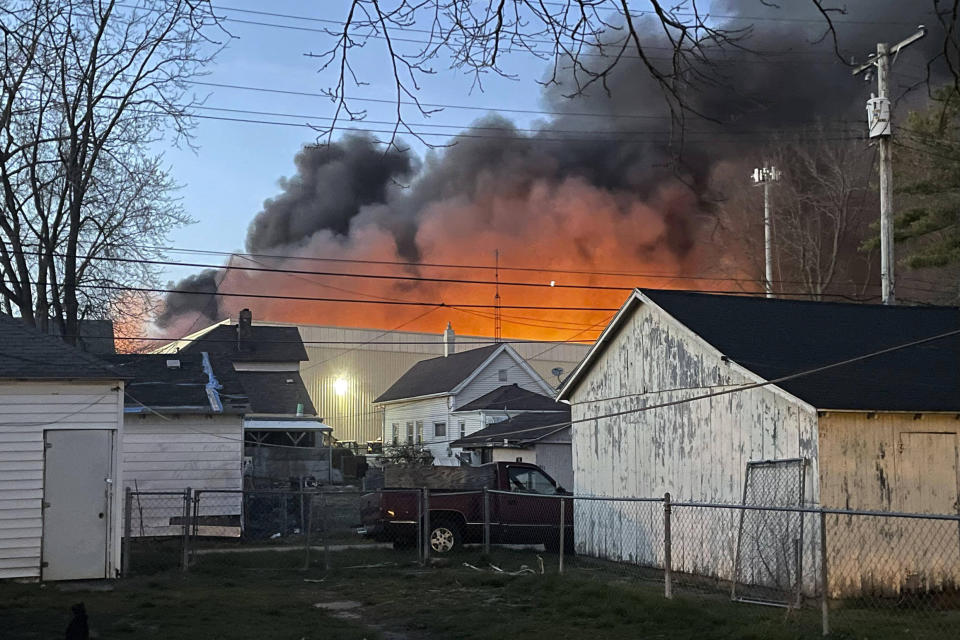Indiana plastics fire spewed toxic chemicals, EPA tests find, including benzene and hydrogen cyanide
A plastics fire in Indiana spewed various toxic chemicals into the air, including hydrogen cyanide and benzene, according to test results from the Environmental Protection Agency.
Officials said Friday that air monitors detected hydrogen cyanide, benzene, chlorine, carbon monoxide and volatile organic compounds in the ground-level smoke.
“We detected some new contaminants right at the incident command post, which is, again, at the center of the evacuation zone," Jason Sewell, the EPA's on-scene coordinator, said at a news conference in Richmond, Indiana.
"The two new contaminants we detected were hydrogen cyanide and benzene. We had not detected those before last night. The fire department jumped on extinguishing the hot spot and that abated," he said.
The EPA said it notified the Richmond Fire Department that it had detected the two dangerous compounds out of concern for firefighters’ safety.
The blaze was first reported on Tuesday afternoon, and soon after, the Wayne County Emergency Management Agency told residents within half a mile to evacuate. That order is still in place.
The warehouse where the fire started contained large amounts of shredded and bulk recycled plastic, and it sent ominous black smoke over Richmond and surrounding towns in eastern Indiana and western Ohio. Local and federal officials warned area residents on Wednesday that smoke from burning plastic could contain cancer-causing toxins.

Hydrogen cyanide, a highly toxic gas, can be fatal depending on the dose and length of exposure.
Benzene is known to cause cancers such as leukemia, multiple myeloma and non-Hodgkin lymphoma in some people with long-term exposure. The World Health Organization has said there’s no safe level of benzene exposure when it comes to cancer risk.
“What we don’t know is the levels and where did they measure them?” said Dr. Arthur Frank, an environmental and occupational health professor at Drexel University.
Christine Stinson, executive director of Wayne County Health Department, said her analysts need time to go over the test results from both air and water samples to understand the long-term health threats people living near the fire site could face.
"We certainly are going to get that information out to the public — what are the risks you have been exposed to if you didn’t honor that evacuation zone," she said, adding, "I don't want to frighten anybody, but this was a plastics fire. There was particulate matter up in the air."
The EPA said Thursday that it also found asbestos in samples of debris that fell in surrounding neighborhoods up to 1.5 miles from the fire. Asbestos can cause several types of cancer, including mesothelioma and lung, laryngeal and ovarian cancer. No amount of exposure is considered safe, according to the Occupational Safety and Health Administration.
Frank said the fire may have spewed additional chemicals that the EPA has not tested for yet.
By Friday afternoon, no flames or smoke were visible, but firefighters will remain at the scene this weekend in case any hot spots reignite, city officials said.
“Stay away from the site,” Richmond fire chief Tim Brown said in a news conference. “Let us take care of it, let us take care of the flare ups and everyone will be safe.”
Environmental health experts said they worry that acute exposure to the chemicals the EPA has identified so far could lead to breathing problems in the short term or cancer in the long term.
“If you think back 20 years ago to the World Trade Center, remember that stuff there burned for days and smoke was coming up and we’re still seeing now disease from people who worked on that pile. This has got a lot of the same stuff,” Frank said.
Andrea De Vizcaya Ruiz, an associate professor of environmental and occupational health at the University of California, Irvine, said that judging by the size of the plume, "this is not something that is going to disperse in a short period."
"It’s going to take a long time for those concentrations to come down," she said.
Area residents have been instructed not to touch debris that has landed in their yards, and especially not use lawnmowers, which could kick up dangerous material and make it easy to inhale.
Ash debris from the fire was all over the farm of Lynn Childers in New Paris, Ohio, 6 miles away. Childers told NBC News on Thursday that he felt irritation in his throat and nose.
"My throat was burning," he said. "I didn't pay any attention to it because I didn't know the severity."
This article was originally published on NBCNews.com

